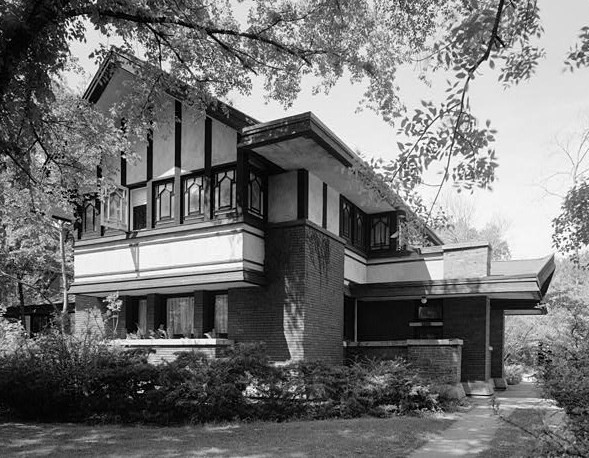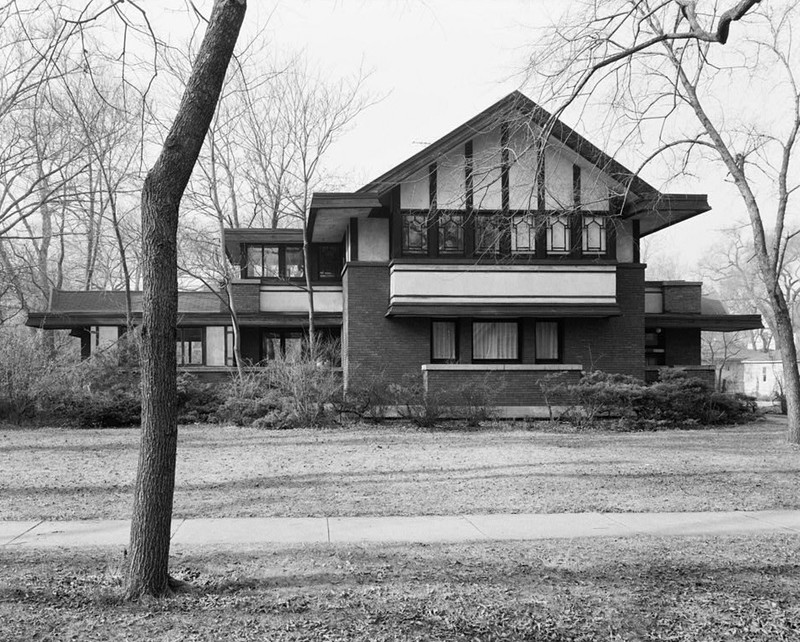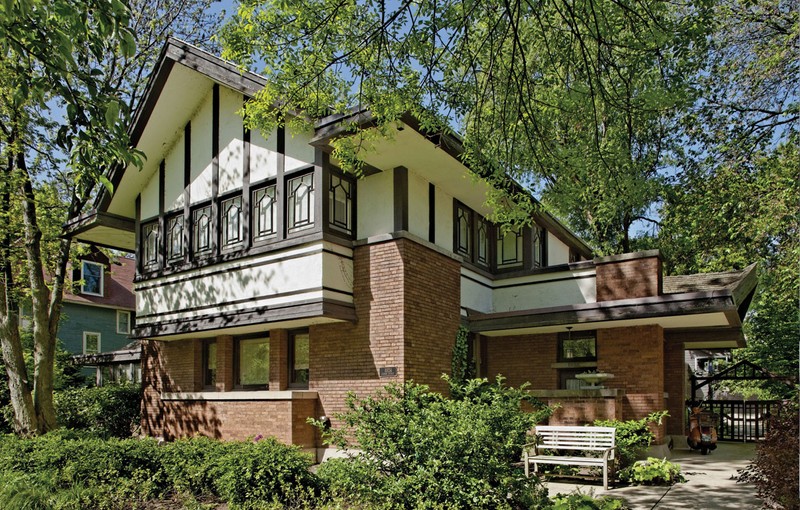Frederick B. Carter Jr. House Designed by Walter Burley Griffin
Introduction
Text-to-speech Audio
The Frederick B. Carter Jr. House (built, 1910) was designed by famous Prairie-School Architect Walter Burley Griffin. The house was one of 130 built in the U.S. by Burley before he moved to Australia, notably to design its capital city of Canberra. For there he moved to India, where he died at the age of 59. Griffin practiced for forty years and arguably stands as the third great member of the Chicago movement after Louis Sullivan and Frank Lloyd Wright.
Images
1967 Photo of Frederick B. Carter, Jr. House, designed in the Prairie School style, by Walter Burley Griffin in 1910.

1967 Photo of Frederick B. Carter, Jr. House, designed in the Prairie School style, by Walter Burley Griffin in 1910.

Modern Picture, taken after award-winning renovations were accomplished by Tom Bassett-Dilly Architect.

Backstory and Context
Text-to-speech Audio
The 1910-built Frederick B. Carter Jr. House was designed by Walter Burley Griffin, arguably the third most prominent figure of the Chicago movement after Louis Sullivan and Frank Lloyd Wright. He designed an abundance of buildings in the U.S. from his Chicago office, planned and designed the capital city of Australia, and then spent the last few years of his life in India.
Griffin (1876-1937) was the eldest of four children, born in Maywood, IL, a suburb of Chicago. During his childhood, his family moved to nearby Oak Park and then to Elmhurst. In 1899 he received a bachelor's degree from the University of Illinois in the architecture program but quickly found a job in Chicago for what became known as the Prairie School architects consisting of such greats as Dwight H. Perkins, Robert C. Spencer, Jr., and H. Webster. Frank Lloyd Wright, who had left the group in 1898 to start his own design studio in Oak Park, Illinois, remained an irregular member. Griffin and the group, including Wright, found profound inspiration in the architectural philosophy of Chicago School architect Louis H. Sullivan.
In 1901, Griffin passed (with high marks) a new Illinois licensing examination, which he was required to pass before entering private practice. At the same time, he was working for the only partner Frank Lloyd Wright ever had, Webster Tomlinson. Through Tomlinson, Griffin was offered a position in Wright's studio located in suburban Oak Park. Though not a full partner of Wright, Griffin viewed his new job with Wright as a step up, believing his role to be that of a junior partner to Wright, who was ten years his senior.
For Wright, the addition of Griffin benefited his practice as college-degreed Grirffin had two years of drafting experience, a license to practice architecture, and extensive experience in landscape architecture, which all bolstered Wright's work at the time (dedicated to suburban housing).
Wright allowed all of his employees to take on outside projects, as long as it didn't interfere with studio work and Griffin took advantage of that policy. In 1901, Griffin received his first independent commission to design a house for W.H. Emery, and by 1906 Griffin enjoyed enough experience to open his own practice. All told, he designed 130 structures from his Chicago office, with nearly half of them being realized. One of those structures, built in 1910, was the Frederick B. Carter Jr. House in Evanston, IL.
Griffin's early buildings, including the Carter House, are distinguished from Wright's Prairie houses of Wright by their inclusion of heavier massing, greater symmetry, their interlocking, multi-level interior spaces, and gabled rather than hipped roofs. Also, by 1910, Griffin produced his first extant urban planning design, and later he created several campus plans as well.
As Griffin honed his urban planning skills, he grew close to fellow architect Marion Lucy Mahony, with whom he knew for a few years; they married on June 29, 1911. Shortly before the Griffins' marriage, the Australian government announced an international competition for the country's new capital city -- Griffin's design was selected the winner among a pool of 137 entries. Suddenly in 1914, Griffin was thrust into the limelight. He left his Chicago practice in the hands of a partner and traveled to Australia, where he built the new city of Canberra, Australia with the help of his wife who ostensibly served as his business partner.
While in Australia, he fell in love with the country and its landscape. He remained in the country from 1914 to 1935 and designed numerous structures. However, professional disagreements pushed Griffin to move again. In September 1935, the nation of India selected Griffin's design for a new library for Lucknow University in northwest India. One month later, in October, he left for India where he again found inspiration. Sadly, though, in February 1937, Griffin died from peritonitis he contracted after attending a banquet given by his benefactor, the Raja of Mahmudabad.
After Griffin died, his wife closed the India office and left the Australian office in the hands of Griffin's partner, Eric Nicholls. She returned to Chicago write her memoirs.
The Frederick B. Carter, Jr. house was included among the National Register of Historic Places in 1974.
Sources
"About the Griffins." PBS: WTTW-Chicago. . Accessed April 20, 2018. http://www.pbs.org/wbgriffin/griffins.htm.
Friedman, Hans A. "Nomination Form: Frederick B. Carter Jr., House." National Register of Historic Places. October 2, 1973. http://gis.hpa.state.il.us/pdfs/200803.pdf
Kruty, Paul. "Biographies: Walter Burley Griffin." Walter Burley Griffin Society of America. Accessed April 20, 2018. http://www.wbgriffinsociety.org/griffins-bio.html.
Perkins, Margery Blair. Evanston: A Tour Through the City's History: A Tour Through the City's History. Evanston: Evanston History Center, 2011.
"Walter Burley Griffin." Australian Walter Burley Griffin Society. Accessed April 20, 2018. http://www.griffinsociety.org/Introducing_the_Griffins/wbg.html.
Photo Sources
1967 Photos: By Richard Nickel — HABS photographer. - http://memory.loc.gov/cgi-bin/displayPhoto.pl?path=/pnp/habshaer/il/il0000/il0080/photos&topImages=0..., Public Domain, https://commons.wikimedia.org/w/index.php?curid=4174339
Modern Picture: Hausmann Photography, found at Tom Bassett-Dilly Architect, "Walter Burley Griffin Carter's House Renovation." http://drawingonplace.com/renovations-additions/walter-burley-griffin-home-renovation/
Friedman, Hans A. "Nomination Form: Frederick B. Carter Jr., House." National Register of Historic Places. October 2, 1973. http://gis.hpa.state.il.us/pdfs/200803.pdf
Kruty, Paul. "Biographies: Walter Burley Griffin." Walter Burley Griffin Society of America. Accessed April 20, 2018. http://www.wbgriffinsociety.org/griffins-bio.html.
Perkins, Margery Blair. Evanston: A Tour Through the City's History: A Tour Through the City's History. Evanston: Evanston History Center, 2011.
"Walter Burley Griffin." Australian Walter Burley Griffin Society. Accessed April 20, 2018. http://www.griffinsociety.org/Introducing_the_Griffins/wbg.html.
Photo Sources
1967 Photos: By Richard Nickel — HABS photographer. - http://memory.loc.gov/cgi-bin/displayPhoto.pl?path=/pnp/habshaer/il/il0000/il0080/photos&topImages=0..., Public Domain, https://commons.wikimedia.org/w/index.php?curid=4174339Modern Picture: Hausmann Photography, found at Tom Bassett-Dilly Architect, "Walter Burley Griffin Carter's House Renovation." http://drawingonplace.com/renovations-additions/walter-burley-griffin-home-renovation/
